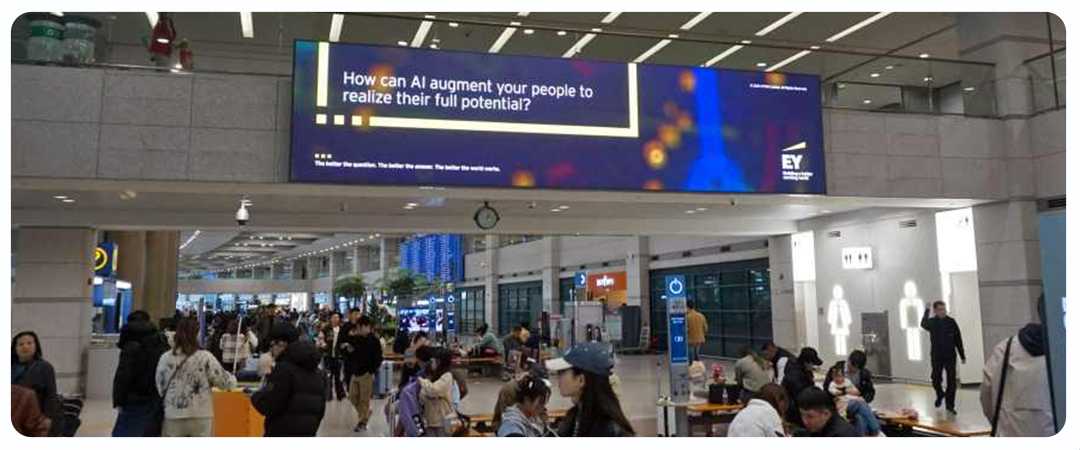
South Korea stands as a powerhouse in global business, technology, and culture, attracting a significant flow of international business leaders, investors, and affluent travelers. For marketers aiming to capture the attention of this influential demographic, understanding the landscape of Airport advertising South Korea is paramount. Airports are not just transit points; they are dynamic environments where high-value audiences spend considerable time, making them prime locations for impactful Out-of-Home (OOH) campaigns. As an expert in Airport and Transit OOH, let me guide you through navigating this vibrant market effectively.
The Significance of South Korean Airports for Reaching Decision-Makers
Major South Korean airports, led by the globally renowned Incheon International Airport (ICN), serve as critical gateways connecting Korea to the world. These hubs process millions of passengers annually, including a substantial percentage of business travelers and high-net-worth individuals. Unlike fleeting online ads, airport OOH offers sustained visibility in environments with high dwell times – think check-in queues, security lines, lounges, and baggage claim areas. This provides a unique opportunity to embed your brand message within the journey of your target audience. Utilizing South Korea airport ads strategically means placing your brand directly in the path of those who shape industries and investment decisions.
Pinpointing Prime OOH Locations in Top South Korean Airports
While Incheon airport advertising often dominates the conversation due to its sheer scale and international traffic (making competition potentially high), a nuanced strategy considers other key airports as well. To maximize reach and impact among business leaders and affluent travelers, focusing on specific zones within the top airports is crucial. Based on passenger flow analysis and audience profiles, here are ten high-impact OOH location types across South Korea's leading airports:
- ICN - Departures Premium Check-in & Security: Targeting passengers flying business or first class, these areas offer high dwell times and exclusivity. Digital screens here allow for dynamic messaging.
- ICN - Arrivals Baggage Claim (Terminals 1 & 2): A universal touchpoint for all arriving international passengers. Large format static or digital displays capture attention during the wait for luggage – a key moment for brand recall. Understanding advertising rates Incheon airport for these prime spots is key.
- ICN - Business & First Class Lounge Corridors/Entrances: Directly reach premium passengers in a relaxed mindset. Subtle, high-quality placements work well here.
- Gimpo International Airport (GMP) - Domestic Departures Concourse: GMP is a major hub for domestic business travel, connecting Seoul to other Korean cities. Advertising here targets frequent domestic business flyers. Consider options beyond standard billboards, like networks of digital airport screens Korea.
- GMP - Main Arrivals Hall: Captures both domestic arrivals and those transferring, offering broad visibility. Gimpo airport advertising here can be surprisingly effective for reaching inter-city business travelers.
- Gimhae International Airport (PUS), Busan - International Departures Duty-Free Zone: Busan's airport serves as a major gateway to the southern region. The duty-free area attracts affluent travelers with time to browse and shop, making it ideal for luxury and premium brands looking to advertise Gimhae airport.
- PUS - International Arrivals Immigration Hall: A bottleneck area where all arriving international passengers must pass, ensuring high visibility for strategically placed OOH.
- Jeju International Airport (CJU) - Main Departures Hall: While known for tourism, Jeju attracts significant investment, particularly in hospitality and development. The main concourse sees massive passenger flow.
- Daegu International Airport (TAE) - Check-in Area: Serving the southeastern region, Daegu is an important industrial and tech hub. The check-in area provides broad reach among regional business travelers.
- ICN - Airport Railroad Express (AREX) Platforms/Interiors: Connecting ICN directly to Seoul Station, the AREX train is heavily used by international business travelers. Advertising here extends reach beyond the terminal buildings.
When considering these locations, analyze the advertising density. Some premium spots might be cluttered; identifying slightly less saturated but still high-traffic zones can offer better standout and potentially a more efficient cost of airport advertising South Korea. Differentiating your message through unique formats or contextually relevant content is also vital.
Embracing Digital and Programmatic Airport OOH
The South Korean market is technologically advanced, and this extends to OOH advertising Korea airport environments. Digital airport ads South Korea are prevalent, offering flexibility for dynamic content, dayparting, and even language adaptation. Furthermore, the rise of programmatic airport ads Korea allows for more sophisticated targeting. Imagine serving specific ad creatives based on flight destinations (indicating traveler origin or purpose) or even based on anonymized data segments associated with business leadership or investment interests. This data-driven approach enhances relevance and campaign efficiency. Exploring digital OOH airport Korea options should be central to any modern airport advertising strategy.
Planning for Success
Successfully executing an airport OOH campaign requires careful planning. Researching specific airport media options and understanding the nuances of each location is essential. Partnering with experienced airport advertising agencies South Korea or directly engaging with South Korea airport media companies can provide invaluable local expertise and access to premium inventory. Clearly defining your target audience, objectives, and budget will guide your decisions on how to advertise in South Korean airports most effectively.
South Korean airports offer a powerful platform to connect with a highly sought-after audience. By strategically selecting locations within key airports like Incheon, Gimpo, and Gimhae, leveraging the growing power of digital and programmatic OOH, and focusing on differentiation, marketers can create impactful campaigns that resonate with business leaders, investors, and affluent global travelers.


